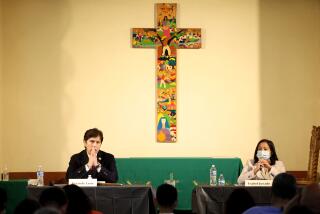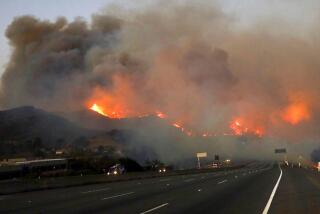Santa Paula Studies Tax for Policing
On the heels of an audit calling for a 50% jump in the police budget, the Santa Paula City Council has decided to explore a number of taxing options to help pay for increased police services.
The council voted 4 to 1 Monday to direct City Manager Wally Bobkiewicz to examine several possibilities, including a parcel tax, a utility tax, an assessment district and a local sales tax. When a funding mechanism is selected, the council will place it on the Nov. 2 ballot.
An additional $2.3 million a year is needed to bolster the Police Department’s budget to provide adequate levels of service for the city of 29,000 and to offer competitive salaries to officers, according to a recent audit. The department, with about 30 officers, has an annual budget is $4.2 million.
“While we have tremendous individual police officers, we pay them among the lowest in Southern California,” Bobkiewicz said. “The council has said that Santa Paula can’t become an aberration in Ventura County. We need to be just as safe as other cities.”
A salary survey of 10 California police departments showed that Santa Paula ranked ninth, with a monthly range of $3,048 to $3,706. That compares with $3,988 to $5,184 for similar-sized Port Hueneme.
Money raised through a tax measure would be used to hire additional officers, raise existing officers’ salaries and get better equipment, Bobkiewicz said.
Although the council asked for an analysis of four tax programs, Vice Mayor Mary Ann Krause said the parcel tax and the utility tax were the most appealing.
Krause said she favored a utility tax.
“This is a type of tax that is growing in popularity because it’s perhaps not as regressive,” she said.
Studies have shown that higher-income residents tend to have higher utility bills, she said, and a utility tax would reflect such differences. Under a parcel tax, however, all property owners would pay the same amount, whether the property was worth $150,000 or $2 million.
Krause described an assessment district as overly complicated and a sales tax as a bad idea, given that Santa Paula is trying to attract retail development.
Councilman Ray Luna was the lone member of the panel to vote against authorizing a study of potential new taxes.
The police audit was released in January after the city’s safest year in decades, with violent and property offenses dropping sharply in 2003. The crime rate of nearly 62 offenses per 1,000 residents in 1993 plummeted to about 20 crimes per 1,000 last year, the city reported.
The 70-page audit found that the Police Department was underfunded and recommended a $2.3-million budget increase. But it also noted that policing costs in cities protected by the Ventura County Sheriff’s Department were as low as or lower than those in Santa Paula.
The study found that in seven benchmark cities, average police spending per resident was $219 a year, while in Santa Paula the figure was $146. But in upscale Moorpark, a sheriff’s contract city, the spending was $120 per resident.
“The city of Santa Paula cannot continue to maintain a separate police agency at the current level of funding,” the audit by Pasadena-based Arroyo Associates concluded.
“The city must either find the means by which it can increase funding ... or investigate contracting for service with the Ventura County Sheriff or other police agency.”
The City Council has since asked the Sheriff’s Department to conduct a feasibility study on providing police services. The study is expected to be completed by late May.
Despite the recent drop in Santa Paula’s crime rate, Bobkiewicz said additional police resources were needed to keep the city’s streets safe.
“We’ve had periods where we haven’t been able to get a handle on crime,” he said.
The council also voted to have Bobkiewicz look into hiring a firm to poll residents on how much they would be willing to pay for improved law enforcement services.
Estimates prepared for the council showed that utility taxes would generate amounts ranging from $679,000 for a 3% tax on all utilities to $1.6 million for a 7% tax.
Parcel tax proceeds would range from $700,000 for a tax of $56.57 per parcel to $2 million for a tax of $161.64 per parcel.
Under a timetable submitted to the council, a ballot measure would have to be authorized by the council by June 28 to qualify for the Nov. 2 election.
Whatever happens, Krause said there was no getting around the need for a new tax.
“Since the summer of 1992, the state has taken well over $6 million from Santa Paula and proposes to take over $1 million in the next year alone,” she said. “We cannot continue to provide our existing police and fire service with that much money taken away, much less make the improvements the audit recommends.”
More to Read
Sign up for Essential California
The most important California stories and recommendations in your inbox every morning.
You may occasionally receive promotional content from the Los Angeles Times.










